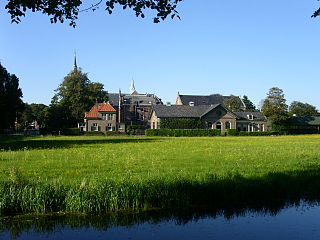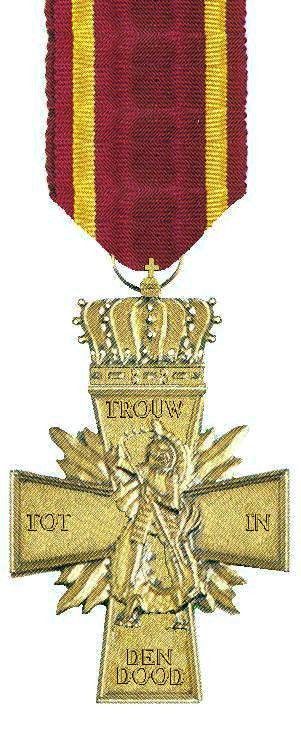
Overveen is a village in North Holland in the Netherlands, in the municipality of Bloemendaal. Overveen lies on the eastern fringe of the North Sea dunes. To the east it borders the built-up areas of Haarlem. A few kilometres to the west of the town lies the Erebegraafplaats Bloemendaal, where many Second World War victims have been reburied, including resistance fighter Hannie Schaft, sculptor and resistance leader Gerrit van der Veen, banker and resistance member Walraven van Hall, Physician and former Wehrmacht officer Karl Groeger, and sculptor and resistance member Johan Limpers. The town is connected to rail service by the Overveen railway station which opened in 1881 on the Haarlem to Zandvoort railway line.

Jannetje Johanna (Jo) Schaft was a Dutch resistance fighter during World War II. She became known as "the girl with the red hair". Her secret name in the resistance movement was "Hannie".
De Grootste Nederlander was a public poll held in 2004 by the broadcasting company KRO of the Publieke Omroep. The series has the BBC's 100 Greatest Britons TV format. During the series, it included individual programmes on the top ten, with viewers having further opportunities to vote after each programme.

Gerrit van der Veen was a Dutch sculptor. He was a member of the Dutch underground, which resisted the German occupation of Amsterdam during World War II. The historian Robert-Jan van Pelt wrote:
In 1940, after the German occupation, van der Veen was one of the few who refused to sign the so-called “Arierverklaring,” the Declaration of Aryan Ancestry. In the years that followed, he tried to help Jews both in practical and symbolic ways. Together with the musician Jan van Gilse and the artist, art historian, and critic Willem Arondeus, van der Veen established the underground organization De Vrije Kunstenaar. Van der Veen and the other artists published a newsletter calling for resistance against the occupation. When the Germans introduced identity documents (Persoonsbewijzen) that distinguished between Jews and non-Jews, van der Veen, Arondeus and the printer Frans Duwaer produced some 80,000 false identity papers.

Overtoomse Veld is a neighborhood of Amsterdam, Netherlands. It is named for the Overtoomse Sluis, which was an old portage point dating from the 14th century on a major cargo route to and from Amsterdam at the junction of two waterschap areas, Hoogheemraadschap van Rijnland and Hoogheemraadschap van Amstelland.

The Eerste Schilderijenzaal, or Painting Gallery I, is one of two art gallery rooms in Teylers Museum and is the oldest art gallery for contemporary Dutch art in the Netherlands. It was built onto the back of Teylers Oval Room in 1838. It was the young museum's first exhibition space for paintings and could be entered through the Oval Room, which was itself located behind the Fundatiehuis, the former home of Pieter Teyler van der Hulst.

The Bureau Bijzondere Opdrachten was a Dutch secret service during World War II. The BBO dispatched secret agents to the German-occupied Netherlands, where they supported the local resistance and carried out sabotage activities.

Henri Frédéric Boot, was a Dutch painter and printmaker mostly active in Haarlem.

The Verzetskruis 1940–1945 is a decoration for valour in the Netherlands. Instituted on May 3, 1946, it was awarded in recognition of the individual courage shown in resistance against the enemies of the Netherlands and for the maintenance of liberties. It is one of the highest decorations in the Netherlands.
Karel August Pekelharing was a Dutch dancer and choreographer who, when World War II broke out, joined the Dutch resistance, and was executed by the German occupying forces in 1944.

Truus Menger-Oversteegen was a Dutch sculptor and painter. During the Second World War she was a member of the anti-Nazi Dutch Resistance, together with her sister, Freddie Oversteegen, and Hannie Schaft.

Onze Kunst van Heden was an exhibition held in the winter of 1939 through 1940 at the Rijksmuseum in Amsterdam. Due to the threat of invasion in the years leading up to World War II, the Netherlands' government stored many items from the Rijksmuseum's permanent collection. The resulting empty gallery space was utilized by contemporary Dutch artists to exhibit and sell their art. It was organized by the director of the Rijksmuseum Frederik Schmidt Degener. The show was open to all artists, with each artist allowed to enter four pieces. 902 artists exhibited 3,200 works of art in 74 rooms and cabinets of the Rijksmuseum.
„De kunstenaar kan in tijden van maatschappelijke benauwenis weinig positiefs doen om rampen af te wenden, maar wel kan hij door mede te helpen nationale uitingen op het eigenaardigst naar voren te brengen het gemeenschapsbesef versterken. Wanneer de belangstelling van het publiek uitgaat naar deze manifestatie, die in zulk een omvang in Holland nog niet gezien is, dan zal menige kunstenaar zich op zijn beurt gesterkt voelen".
"The artist can do little positive in times of social distress to avert disasters, but he can, by helping to bring out national expressions in the most idiosyncratic way, strengthen the sense of community. When the public is interested in this event, which has not yet been seen to such an extent in Holland, many artists will feel strengthened in turn."

Paul Gustave Sidonie Guermonprez (1908–1944) was a Belgium–born Dutch photographer, graphic designer, and a Dutch resistance fighter during World War II.













